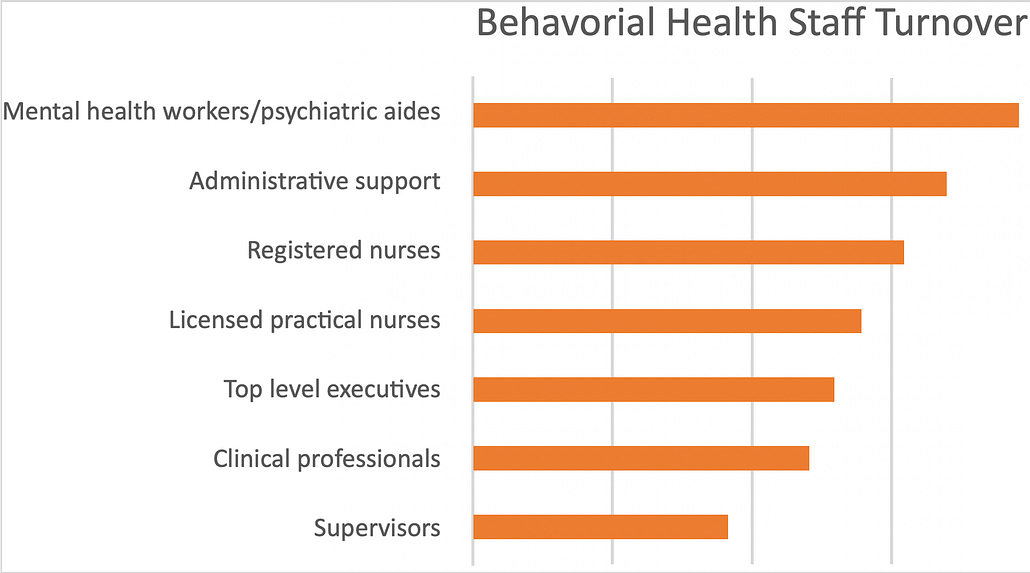Keeping community health workers and other professionals who work in behavioral health in their jobs is a big problem for healthcare organizations. The burnout and compassion fatigue drives people to leave their jobs. If you want to keep your CHWs working with clients—and keep them happy while they’re doing it—you’ll need to find ways to keep these workers satisfied and healthy.
Turnover rates at behavioral health facilities averaged more than 30% in 2022, according to a recent study.
Those rates vary by job—and most CHWs would be classified under the last item with the highest turnover:

- Supervisors: 17.37%
- Clinical professionals: 22.91%
- Top level executives: 24.61%
- Licensed practical nurses: 26.43%
- Registered nurses: 29.36%
- Administrative support: 32.24%
- Mental health workers/psychiatric aides: 37.17%
In healthcare, especially in behavioral health, employees must feel engaged to stay in their job. When they’re engaged, they’re more likely to stay. This, in turn, is one of the best ways to head off burnout and turnover among CHWs and healthcare workers.
You, as a leader, can make a big difference by creating a work atmosphere where your team feels valued and connected to your program’s goals. This frequent engagement will help you notice when employees are feeling worn out. You can step in and help through training and resources that focus on self-care and staying resilient.
Work Towards High-Level Efficiency
Simply put, when your internal systems run smoothly, your CHW team works better. If they know what to do and can follow clear protocols, they can focus more on client and patient care rather than struggling through red tape. This allows them to follow the passion that led them to the job in the first place.
Consider using technology that streamlines administrative tasks. This can free up time for client visits.
Your agency should also work to create policies and practices that support a healthy work environment.
Create a People-First Culture
Some programs can become so focused on improving the lives of their target clients that they overlook the well-being of their internal team. You can avoid this by creating a people-first culture.
Let your team know they’re the most important asset of the organization, and consider their needs in all decision-making processes. This includes providing:
- Support
- Resources
- Opportunities for growth
- A positive work environment
- Respect
- Engagement
Employees thrive in workplaces where they’re happy, motivated, and able to grow both personally and professionally. When they have a workplace they love, they’re more likely to stay.
Focus on the entire employee lifecycle, from the hiring process to retirement. Design each stage with their well-being and professional satisfaction in mind. This holistic approach ensures team members feel valued throughout their employment.
Build Programs to Keep CHWs On Board
You can keep CHWs on board through programs that are designed to keep them actively engaged in their job. Some examples are:
- Pairing new CHWs with mentors
- Doing activities to build teamwork among CHWs
- Letting CHWs help make decisions, so they feel like they own a part of the job
- Addressing burnout through education, stress management, workload management and work-life balance.
Give new CHWs a good start with lots of support, and check in regularly to see how they’re doing. They’ll appreciate chances to learn new skills and grow.
This should extend to payment and benefits, which should be a living wage and comparable to other employers’ packages.
Invest in Training and Technology
Investing in continuing education through online learning can keep people happy and engaged in their job. You can keep your team’s skills up to date with the latest best practices and you show your commitment to their professional development.
Studies show that elearning is strongly linked to employee satisfaction. One study found that employees perceive e-learning systems as useful and satisfying, and their use of these systems is significantly associated with overall job outcomes. This means that using e-learning systems can lead to positive results in terms of knowledge, skills, and work attitudes being transferred to the job.
Take Lessons from Behavioral Health
Remember that the same techniques your CHW team is using to support clients can be the same techniques you use to support your team. Follow these lessons from behaviroal health:
Schedule Regular Check-Ins
Have regular conversations with employees to check on their well-being and offer support when needed. Provide resources and training on stress management and self-care to help them cope better with job demands.
Promote a Supportive Workplace Culture
Create a friendly and supportive environment where employees feel comfortable talking openly, collaborating, and respecting each other. Encourage mentorship programs and buddy systems to provide additional support and guidance.
Support Stress Management
Offer resources and strategies to help employees manage stress effectively. This can include workshops, mindfulness training, or access to counseling services. Encourage healthy coping mechanisms and provide guidance on maintaining work-life balance. You can help CHWs stay resilient and perform better in their roles by addressing stress proactively.
Behavioral health retention can be a challenge for employers, but it’s definitely manageable. Make an effort across all areas of your organization to let CHWs know they’re needed and appreciated. From cultivating a supportive culture and embracing operational efficiencies to investing in employee growth and addressing burnout, you can help your team engage and thrive.


